Are you a fan of nasi goreng? Nasi goreng, or fried rice, is one of Indonesia’s most famous cuisines worldwide.
Yes, fried rice is one of Indonesia’s top cuisines, alongside soto, rendang, gado-gado, and others. This food has transcended borders and is now enjoyed by people from various cultures, making it a truly global dish.
It’s fascinating to discover that there are hundreds of different types of fried rice in Indonesia, each with its own unique blend of ingredients and seasonings. This diversity is a testament to the rich culinary heritage of the country.
A culinary expert from the Faculty of Agricultural Technology UGM Dwi Larasatie Nur Fibri said this. She said fried rice is a unique and special food because there are so many varieties.
“There are at least 104 types of fried rice spread in Indonesia, consisting of 36 types of fried rice that can be traced to their origin and 59 others are types of fried rice development that cannot be traced to their origin,” she explained in a book review event entitled Indonesian Fried Rice, World Taste on Thursday, July 15, 2024.
The many types of fried rice make it unique. It encourages curiosity to try other varieties.
As an expat in Indonesia, don’t miss the opportunity to try the many variants of fried rice for an unforgettable culinary experience.
Want to know more about Indonesian fried rice? Let’s take a look at its history.
History of Indonesian Nasi Goreng
The history and origin of fried rice has a connection with the existence of the Srivijaya Kingdom in Indonesia. Quoting from the book Roots of Indonesian Media Episode-01 (2014: 37), the history of fried rice began in the Sriwijaya era around the 10th century.
Traders from China introduced the food, chinese fried rice mixed with various spices.
Before it became popular in Indonesian and Malay, fried rice actually originated in China with a long history. The Spruce Eats state that fried rice was first discovered in Yangzhou, China during the Sui dynasty, around 589-618 AD.
After that, Chinese immigrants at that time also began to settle in the archipelago with their culture.
Originally, fried rice came about due to the taboo against throwing away food, including rice. So they made with leftover rice.
This condition led to the initiative to cook yesterday’s leftover rice by frying it in the morning. Therefore, it’s no wonder that fried rice nowadays is often the choice of menu for breakfast.
Dwi also mentioned that fried rice is one of the solutions to avoid food waste.
“People who have a problem with rice stock that often does not run out and become something that is left over, then fry the rice is the answer to processing rice so that food waste does not occur,” said Dwi.
Popular Types of Indonesian Nasi Goreng From Across The Country
Referring to the hundreds of types of fried rice in Indonesia, there are some very popular types that you can get in major cities in Indonesia.
1. Nasi Goreng Bali
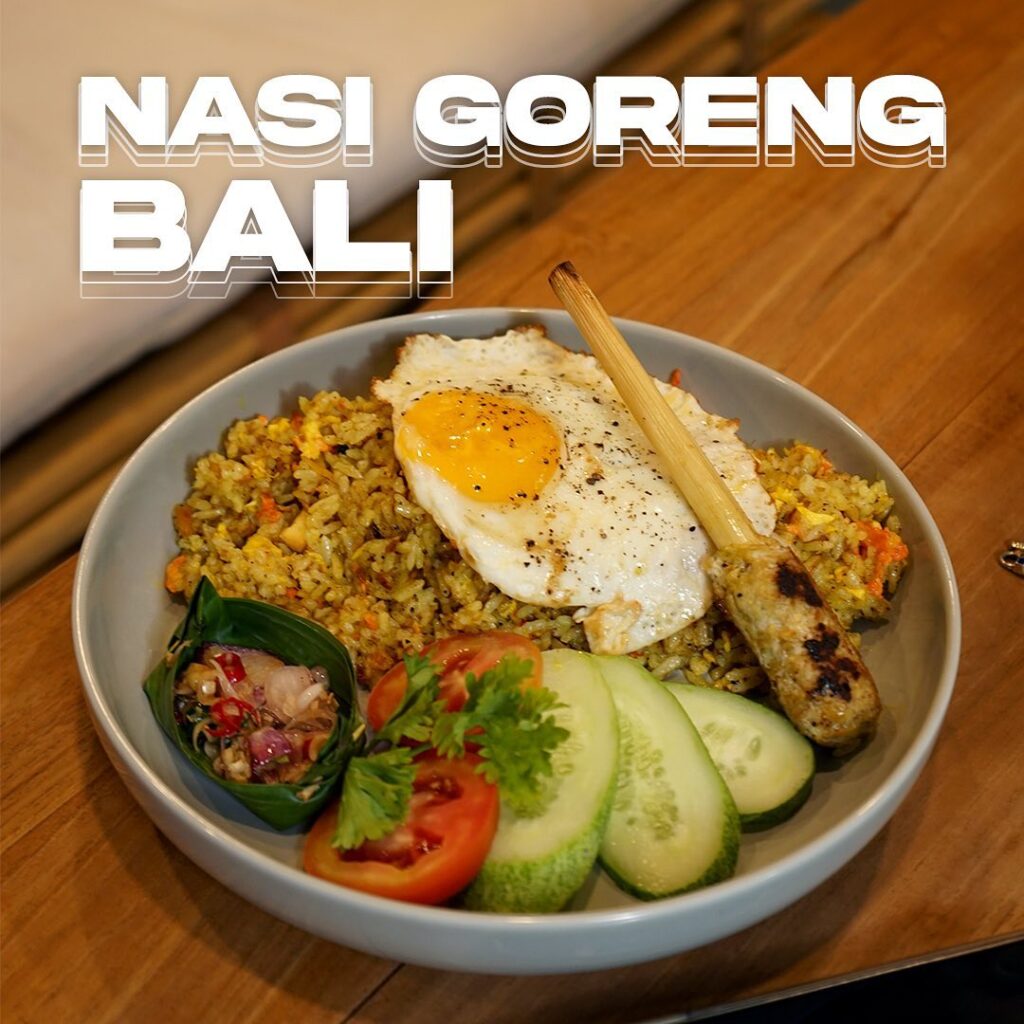
Nasi Goreng Bali is synonymous with fresh and unique spices, usually served with satay lilit. This dish is very popular, especially in Bali because the spices are delicious and fragrant.
The marinade is made from bay leaves, lime leaves, turmeric, candlenuts, oyster sauce, soy sauce, and shrimp paste or terasi. The taste is dominantly savoury but unique because it is accompanied by a fragrant aroma that arouses the appetite.
2. Nasi Goreng Jawa
Another type of Indonesian nasi goreng is Javanese fried rice, which has a dominant sweet-savoury flavour because it uses sweet soy sauce or kecap manis as the main seasoning ingredient.
People can commonly find Javanese fried rice in street food and five-star restaurants. It is usually served with a filling of scrambled eggs, chicken fried rice, vegetables and sometimes fried onions and sunny side up eggs.
Lets make nasi goreng!
Javanese-style nasi goreng dishes are easiest to make at home with simple ingredients. Here are some simple Indonesian fried rice recipes:
Ingredients:
- White rice, use a day old rice and not freshly cooked rice
- 1 egg
- 1/4 cabbage
- 1 clove of garlic
- 3 shallots
- 1/2 teaspoon pepper
- sugar
- salt
- 1 large red chili pepper
- 3 cayenne pepper seeds
- 1 small tomato
- Kecap manis
- Fish sauce (if needed)
Step by step nasi goreng recipe:
- Puree the spices (shallots, garlic, pepper, chili and tomato).
- Heat the cooking oil and use large pan or wok.
- Saute the spices until fragrant. Add cabbage. Keep sauteing until the cabbage becomes wilted.
- Add the egg, then scramble. Cook the egg, then add the rice. Stir-fry in high heat until the seasoning is evenly distributed.
- Add kecap manis and fish sauce. Season with salt and sugar. Stir again. Taste it, if the taste is right, fry again until it evenly cooked.
- You may like to serve with fried egg on top and slice of cucumber.
3. Nasi Goreng Aceh
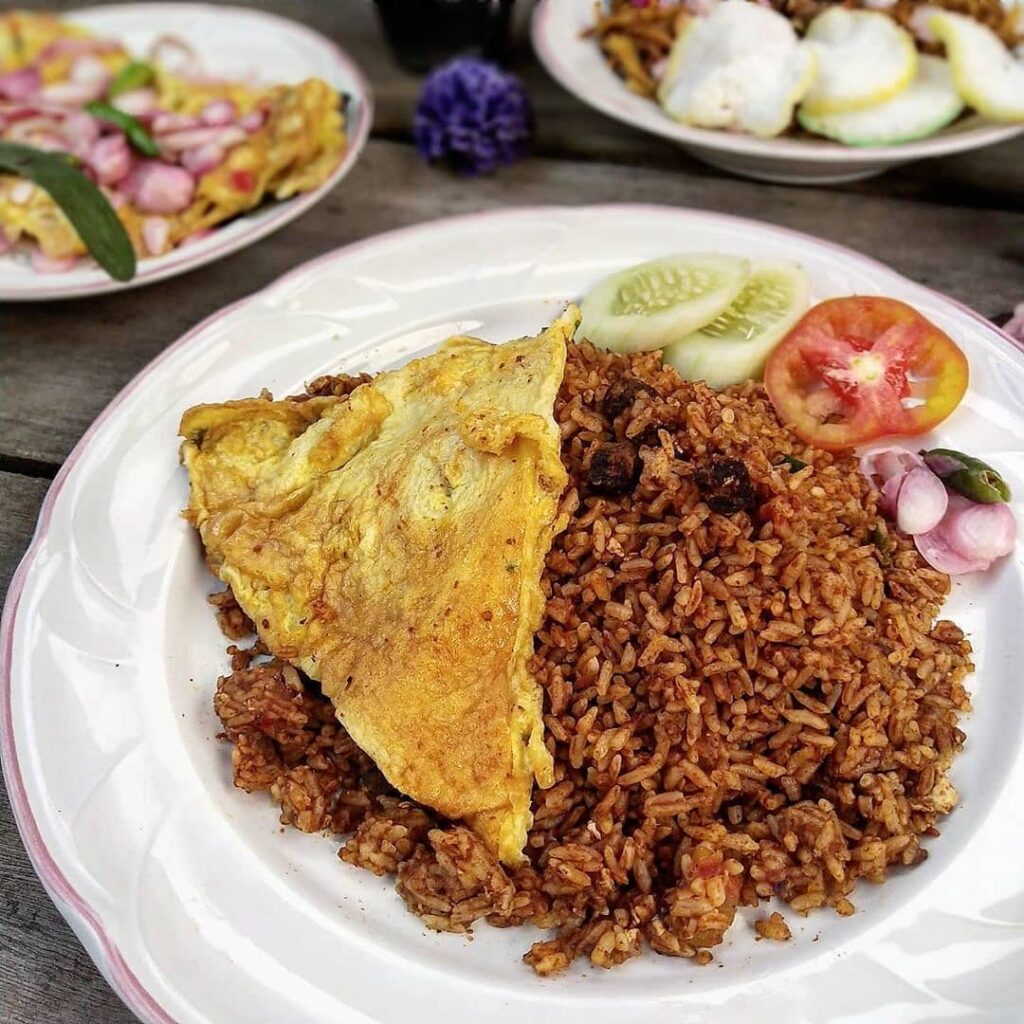
You can try this version of Indonesian nasi goreng from Aceh, which is as aromatic and full of spices. This Acehnese rice dish is heavily seasoned by Indian and Arabic cuisine with strong and fragrant spices.
Spices used in Aceh nasi goreng include shallots, garlic, curly chilli, pepper, cinnamon, star anise, nutmeg, candlenuts, and coriander.
4. Nasi Goreng Kuah Kediri
Another unique Indonesian cuisine comes from the Kediri area. In Kediri, they prepare nasi goreng in a soupy style, which sets it apart from the usual fried version. It sounds strange, but it turns out that many people like to eat it especially when the air is cold, for example during the rainy season.
The seasoning remains the same as the usual nasi goreng, while we make the soup from savory warm chicken broth.
5. Nasi Goreng Teri Medan
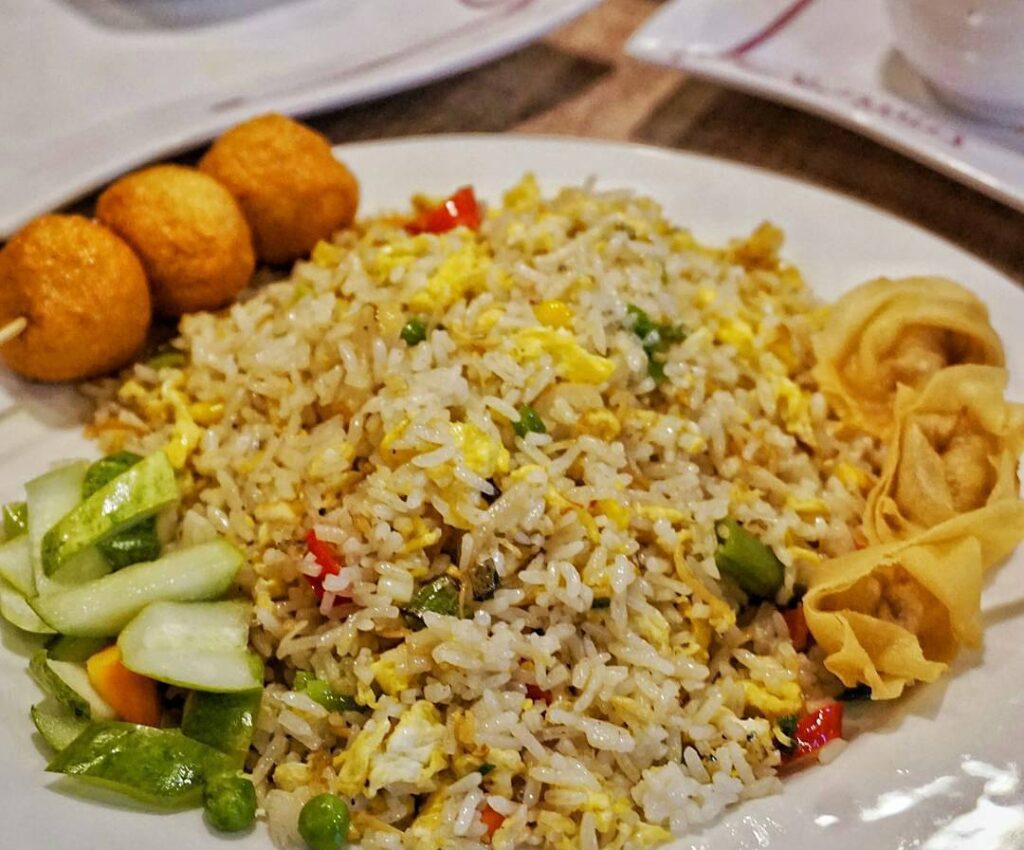
One of Indonesia nasi goreng’s favourite types of fried rice dish. Its salty and savoury taste makes anyone love it because the recipe makes it an ‘anti-hassle club’, which can be a mainstay when cooking with your beloved family.
Teri Medan is very suitable for hot rice because the taste is not too salty, and the size of the fish is small, becoming a perfect blend when cooked.
6. Nasi Goreng Merah East Java
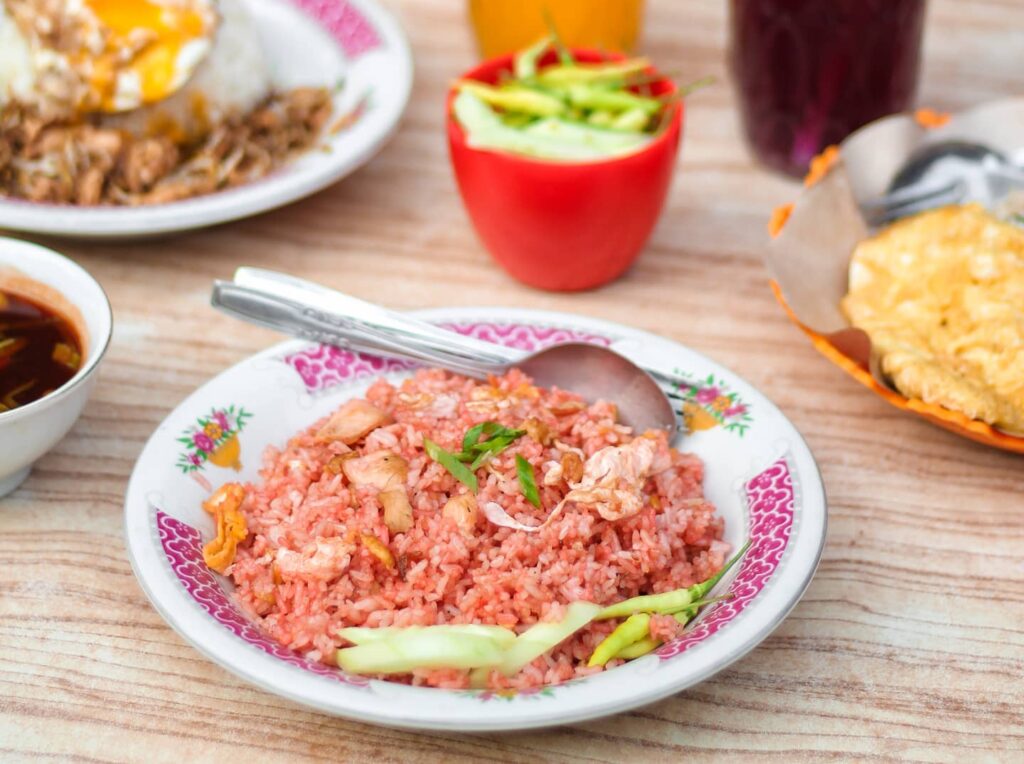
This is a typical rice dish that’s come with a fiery red color because the seasoning is mixed with chilli paste. It is usually served with mustard greens, white cabbage, and shredded chicken. This spicy rice dish is even more delicious if you add pickled cucumber and whole chilli as a compliment.
In general, you can find this delicious nasi goreng at street vendors for affordable prices. It is predominantly savoury but not reallly spicy, often served in large portions.
7. Mawut or Magelangan
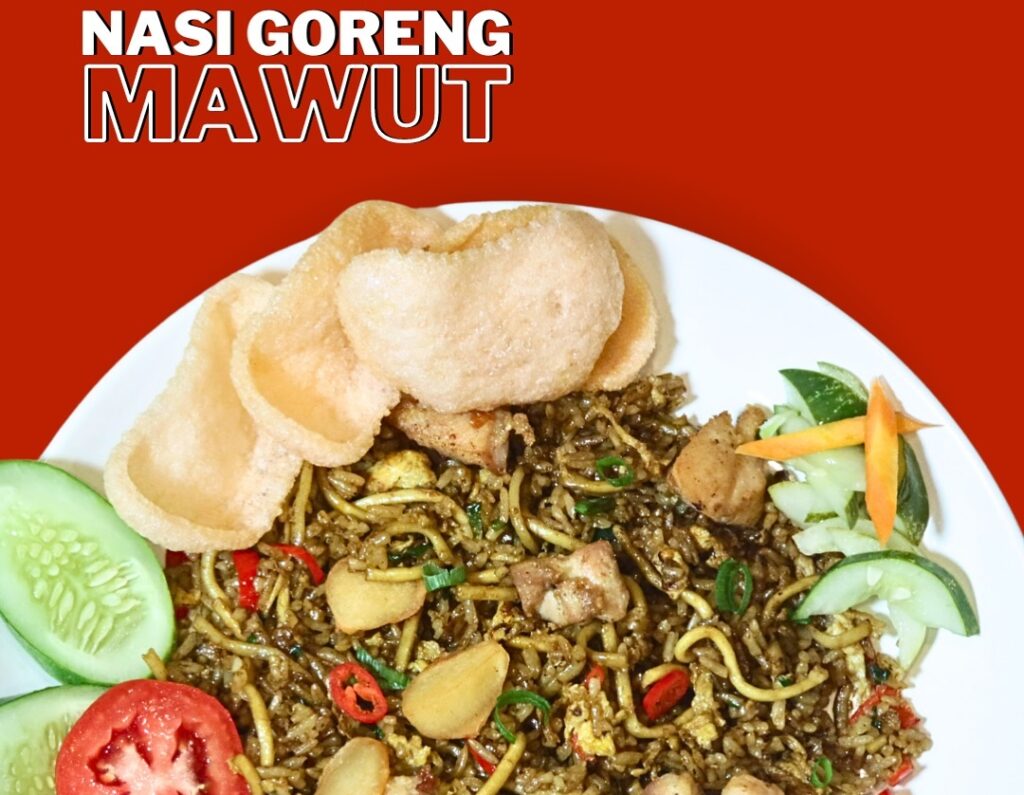
Ever eaten or perhaps seen a stir-fried rice with noodles? If so, it’s called nasi mawut or magelangan. The taste of mawut or magelangan rice is savory-sweet, usually topped with scrambled eggs and slices of fresh cucumber.
Mawut rice is usually served in large portions, especially in East Java. Magelangan or mawut rice is popular and widely loved, especially among students, because the large portion is quite filling and the price is very affordable.
8. Nasi Goreng Babat
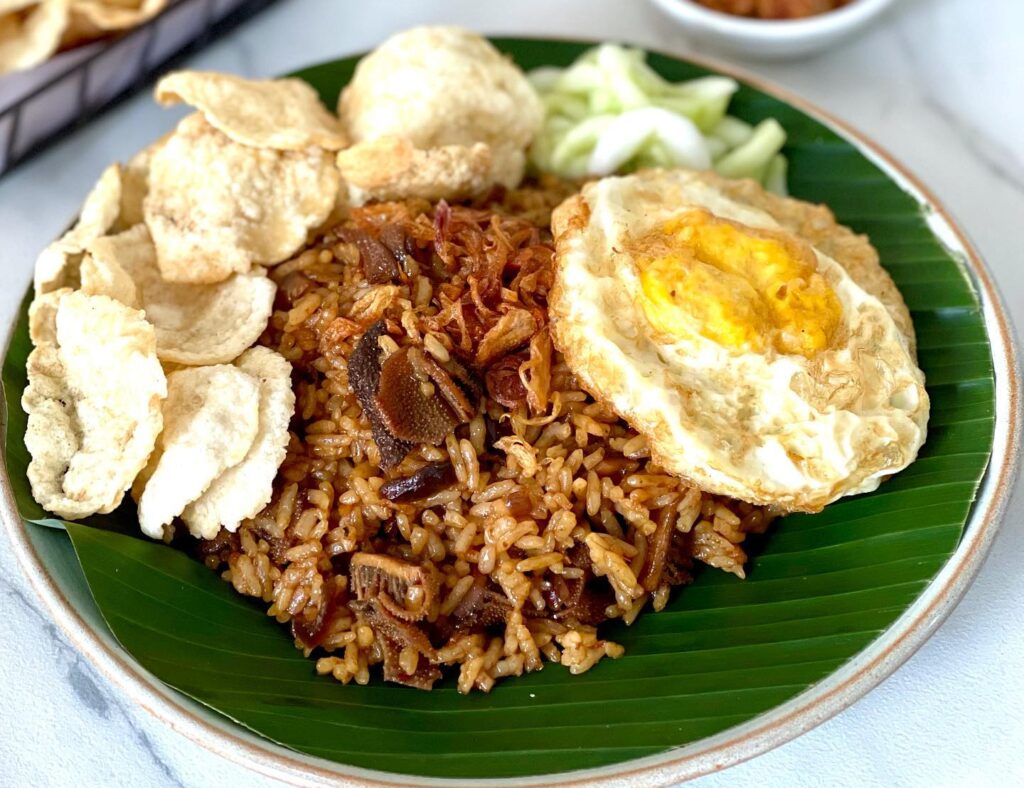
Babat fried rice is a Semarang speciality stuffed with beef tripe. Of course, the beef tripe or babat is processed in advance so that it is more tender. This fried rice is best eaten warm.
This type of Semarang fried rice has a pretty strong flavour, so it’s best eaten when it’s still warm. Even though the contents are pieces of tripe, there is no need to worry about the taste, as they are odourless and even savoury on the tongue.
9. Nasi Goreng Kambing/Goat

Love to eat fried rice with strong spices? Try eating goat fried rice, the flavor and aroma of the spices are similar to Middle Eastern briyani rice but less intense.
The filling is goat meat that is diced rather large or sometimes sliced rather thin; the rice also uses Indonesian rice (not basmati rice). The seasoning tends to be strong and fragrant because it is made from spices, such as turmeric, cardamom, and lemongrass. This dish is usually served with melinjo crackers and slices of pickled cucumber on the side.
10. Nasi Goreng Padang
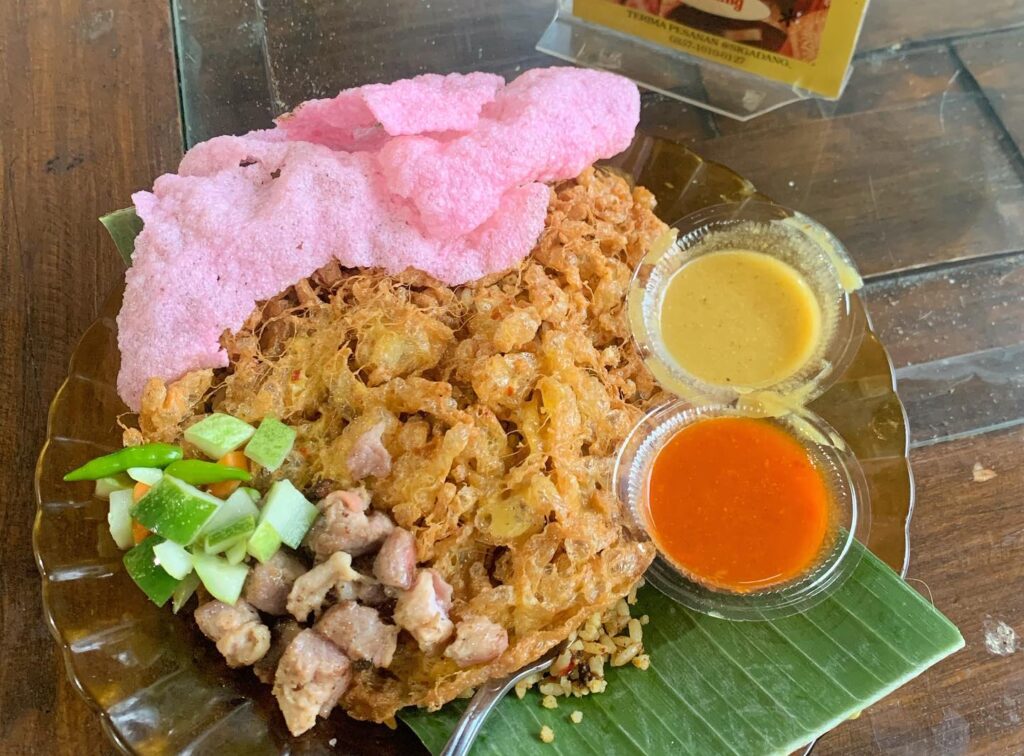
Besides being famous for rendang, satay padang, and egg balado, another famous West Sumatran speciality is nasi goreng Padang.
As is known, fried rice in every region in the archipelago has a unique recipe.
The characteristics of each type of fried rice are usually based on the tastes or tongues of the people in the area.
Well, specifically for Padang, fried rice is different from fried rice in general because the taste tends to be spicy and salty rather than sweet. The colour also tends to be red rather than brown. The texture of the fried rice is also drier because this type of Indonesian food using only a little oil.
The advantage is in the sprinkling of celery leaves and shredded fried chicken, which adds to its Sumatran characteristics. Cracker crumbs or krupuk also add to your appetite.
The Differences between Indonesian, Malaysian, and Singaporean Fried Rice

Some differences between Indonesian, Malaysian, and Singaporean Fried Rice
Indonesian nasi goreng is usually prepared and served with chicken, fried eggs, dried shrimp and vegetables.
According to idntimes, some of the main differences between the Indonesian version of fried rice compared to fried rice in other regions is that it is cooked in sweet soy sauce.
It is often accompanied by additional ingredients such as fried eggs, fried chicken, and satay, as well as condiments such as sambal, pickles, and crackers. It is served in Indonesia, Malaysia, Singapore and most neighbouring countries and is famous in the Netherlands.
Pattaya Fried Rice Malay Style
Pattaya fried rice is a Southeast Asian dish served wrapped in an egg omelette. It is generally mixed with various vegetables and meat, and tomato sauce is added. In Indonesia, the dish is called envelope fried rice.
Sambal Fried Rice Singapore Style
Singaporean sambal fried rice is a variety of fried rice made with sambal, chilli, and a belachan-based condiment, which is influenced by Indonesian and Malay influences.
Javanese Fried Rice Indonesian Nasi Goreng Style
Javanese fried rice is characterized by its brownish-red colour and the use of sambal ulek as a condiment. Another characteristic of Javanese fried rice is that it is traditionally cooked using tungku.












































